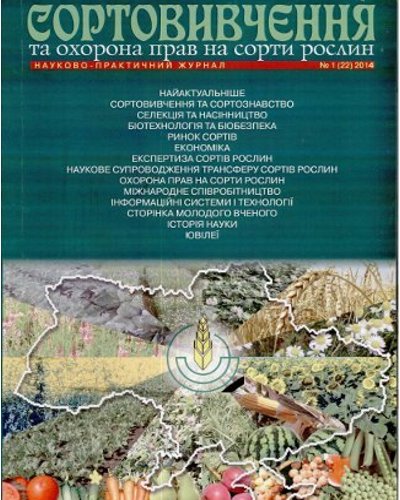Agroecological features of the new varieties soft winter wheat Yuvivata 60
DOI:
https://doi.org/10.21498/2518-1017.1(22).2014.56282Keywords:
soft winter wheat, a new variety, agroecological features by economically valuable indicatorsAbstract
The main factor, and cost-effective rapid increase in yield of all crops and raising its quality is an innovative process for the creation and introduction of new varieties. Overall condition of use in the production of new varieties is very unsatisfactory. For this year the country loses more than 1.5 mln. tonnes of grains of winter cereals. Currently, the requirements for soft winter wheat, as a factor of sustainable productivity, increase. Despite the obvious advances in breeding wheat varieties as genetic yield potential of more than 10 t/ha, the actual implementation of it is around 50 %. Therefore remains an urgent problem of developing varieties with high potential and implementation of evidence-based their growth. Thus, the genetic yield potential genotype implemented with a balanced exposure of a number of factors. The purpose of research – create a soft winter wheat variety with well-defined ecological and adaptive properties and high quantitative and qualitative indicators of grain yield, varieties show ability to withstand adverse abiotic, biotic and anthropogenic factors of the environment for future breeding. Stated agroecological characteristics of variety soft winter wheat Yuvivata 60 by economically valuable indicators. Performed a detailed description of the new variety wheat based on morphological and biological characteristics. Showing environmental features Yuvivata 60 (in terms of genotypic effect and degree of plasticity) under different conditions ecotops of Ukraine. For agricultural producers proposed of adaptive variety soft winter wheat Yuvivata 60, that will provide guaranteed high quality and grain yield.Downloads
References
Жученко А.А. Адаптивный потенциал культурных растений: Экол.-генет. основы / А.А. Жученко // АН МССР. Ин-т экол. генетики. – Кишинев: Штиин- ца, 1988. – 767 с.
Жученко А.А. Фундаментальные и прикладные научные приоритеты адаптивной интенсификации растениеводства в XXI веке / А.А. Жученко – Саратов: ООО «Новая газета», 2000. – 275 с.
Спеціальна селекція і насінництво польових культур: навч. посібн.; за ред. В.В. Кириченка. – Харків: Ін-т рослин. ім. В.Я. Юр’єва НААНУ, 2010. – С. 3.
Улич Л.І. Ідентифікація генотипів пшениці м’якої за морфологічними ознаками та біологічними властивостями / Л.І. Улич, М.М. Таганцова, В.М. Матус, Ю.Ф. Терещенко // Зб. наук. пр. Уманського НУС. – Умань, 2011. – Вип. 75. – Ч. 1. Агрономія. – С.181–190.
Тищенко В.Н. Генетические основы адаптивной селекции озимой пшеницы: монографія / В.Н. Тищенко, Н.М. Чекалин – Полтава: ПДАА, 2005. – 243 с.
Кулинкович С.Н. Технология возделывания озимой пшеницы / С.Н. Кулинкович // Белорусское сельское хозяйство. – 2006. – No 9 (53). – С. 46–56.
Гешеле Э.Э. Методическое руководство по фитопатологической оценке зерновых культур / Э.Э. Гешеле. – Одесса: ВСГИ, 1971. – С. 36–59.
Методика державного сортовипробування сільськогосподарських культур; ред. В.В. Волкодав; Державна комісія України по випробуванню та охороні сортів рослин. – К.: Алефа, 2000. – Вип. 1. – 100 с.
Серебряков И.Г. Морфология вегетативних органов высших растений / И.Г. Серебряков. – М.: Сов. наука, 1952. – 391 с.
Куперман Ф.М. Морфофизиология растений. Морфофизиологический анализ этапов органогенеза различных жизненных форм покрытосемянных растений: учеб. пособие для биол. спец. ун-тов / Ф.М. Куперман. – 3-е изд., перераб. и доп. – М.: Высш. школа, 1977. – 288 с.
Майсурян Н.А. Практикум по растениеводству / Н.А. Майсурян. – Изд. 6-е. – М.: Колос, 1970. – 446 с.
Доспехов Б.А. Методика полевого опыта / Б.А. Доспехов. – М.: Агропромиздат, 1985. – 351 с.
Downloads
Published
How to Cite
Issue
Section
License
Copyright (c) 2014 Ukrainian Institute for Plant Variety Examination

This work is licensed under a Creative Commons Attribution-ShareAlike 4.0 International License.
Starting in 2022, the copyright to the publication remains with the authors
Our journal abides by the CREATIVE COMMONS copyright rights and permissions for open access journals.
Authors, who are published in this journal, agree to the following conditions:
- The authors reserve the right to authorship of the work and pass the first publication right of this work to the journal under the terms of a Creative Commons Attribution License, which allows others to freely distribute the published research with the obligatory reference to the authors of the original work and the first publication of the work in this journal.
- The authors have the right to conclude separate supplement agreements that relate to non-exclusive work distribution in the form in which it has been published by the journal (for example, to upload the work to the online storage of the journal or publish it as part of a monograph), provided that the reference to the first publication of the work in this journal is included.

























 Ukrainian Institute for Plant Varieties Examination
Ukrainian Institute for Plant Varieties Examination  Селекційно-генетичний інститут
Селекційно-генетичний інститут Institute of Plant Physiology and Genetics of the National Academy of Sciences of Ukraine
Institute of Plant Physiology and Genetics of the National Academy of Sciences of Ukraine
 The National Academy of Agrarian Sciences of Ukraine
The National Academy of Agrarian Sciences of Ukraine